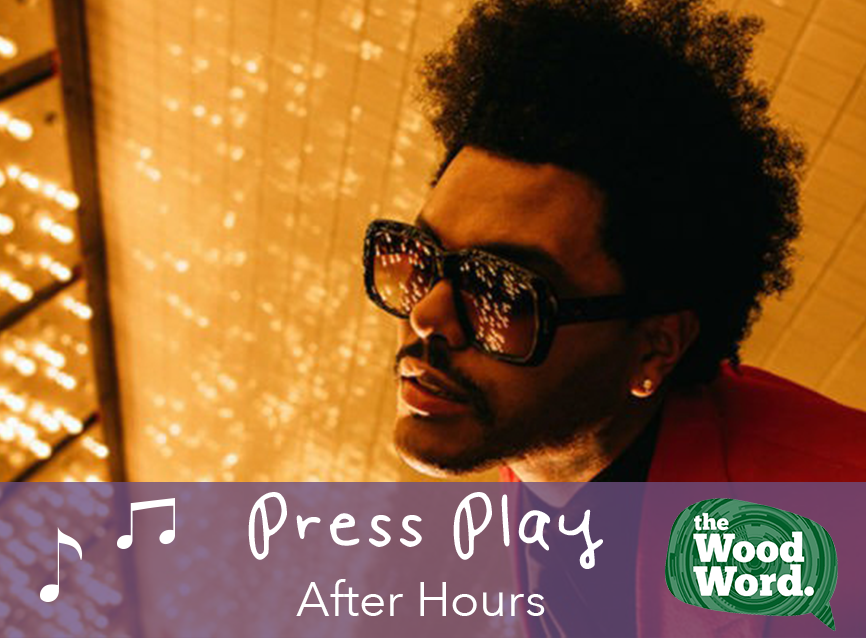Press Play: The Weeknd evolves his dark mystique with ‘After Hours’
April 7, 2020
It has been roughly four years since rhythm and blues (R&B) musician Abel Tesfaye, professionally known as The Weeknd, released a full album.
His last studio album, “Starboy,” received generally positive reviews from critics and debuted at number one on the U.S. Billboard 200 with 348,000 album-equivalent units, 209,000 of which were pure album sales. The album also won Tesfaye a Grammy in 2018 for the Best Urban Contemporary Album.
“Starboy” saw the singer transition from dark R&B tunes to pure pop collaborations, working with artists such as Lil Uzi Vert on “UnFazed,” Lana Del Rey on “Lust for Life” and Kendrick Lamar on “Pray for Me,” the latter of which became a highlight on the soundtrack for the Academy Award-winning film “Black Panther.” These collaborations, in addition to efforts within the genre of electro-pop, broadened his musical range and introduced many to his entire discography.
As a whole, the album served to tell more about Tesfaye’s increasing success in the mainstream while also discussing his love life through his raw lyrics.
In 2018, Tesfaye released an extended play (EP) titled “My Dear Melancholy,” which showcases a return to the image and sound found on a trilogy of mixtapes he released earlier in his career.
The sounds that make up the EP harshly contrast those heard on his last studio album, symbolizing a switch from bright daylight to stark darkness by expressing his break up with singer Selena Gomez and other lovers.
He manages to concisely showcase the story of his relationship through his honest, heartfelt lyrics on songs like “Call Out My Name,” “Hurt You” and “Privilege.”
The EP also features collaborations with French musician and DJ Gesaffelstein, who Tesfaye would work with once again the following year with the release of the dark and powerful track “Lost in the Fire.”
To start the promotion for his next album, Tesfaye released the lead single “Heartless” in November and has garnered much praise since.
The single expresses the singer falling back into the reckless behaviors that he describes in many songs in his discography, such as alcoholism, drug usage and sex, over a trap-inspired beat produced by DJ Metro Boomin.
He followed up two days later with his second single “Blinding Lights,” which sees the singer expressing the idea of escapism through 1980’s inspired electro-pop.
“Heartless” and “Blinding Lights” were both certified platinum by the Recording Industry Association of America (RIAA) and the release of his fourth studio album “After Hours” came right after.
As the two singles were remarkably distinct and clashing stylistically, it initially seemed clear the singer was experimenting with his sound for his latest effort.
How does The Weeknd work to make a cohesive album with many altering styles of sound?
Truthfully, the album is not all that different from his previous work.
It was shocking to hear how familiar the first half of the album was to some of his previous tracks.
It is not necessarily a bad thing. It is admirable to see what The Weeknd does to not only engage fans from his earlier releases, but also fans of his later work as well.
The opening track “Alone Again” features a synth-inspired trap beat which provides an eerie welcome for the album. The song feels like a combination of the energy found in “Party Monster” off of “Starboy” and the emotional lyricism heard throughout “My Dear Melancholy.”
“Too Late” stresses Tesfaye’s remorse towards a former lover, which is intensified by simplistic yet incredibly rhythmic production.
Two instances where the lyrics and production felt like a perfect match for each other were in “Hardest To Love” and “Scared To Live,” the latter of which the singer debuted on the March 8 episode of “Saturday Night Live.” In addition to expressing his authentic feelings towards a breakup, Tesfaye also interpolates lyrics from Elton John’s “Your Song” throughout “Scared To Live.”
“Snowchild” feels very similar to the rest of his discography, but after listening more, it feels like something that he made solely based on the subject matter of his rise to fame and the struggles coming from it.
To conclude the first half of the album, “Escape From LA” sees the singer use the metaphor of the fast-paced lifestyle of Los Angeles to represent a relationship and how he aspires to leave the area to improve his health.
The second half of the album begins with “Faith,” which upon first listen is a slow burn, but can be appreciated after listening more. If I were to rank every song on the album, “Faith” would be my least favorite song as I don’t believe it adds anything interesting to the effort.
“In Your Eyes” and “Save Your Tears” both involve the singer attempting to find a source of escapism over 1980s inspired synth-heavy instrumentation, comparable to that found in “Blinding Lights.”
The title track “After Hours” and closer “Until I Bleed Out” blend deep electronic-influenced sounds with some of the most sincere lyrics on the album as a whole, with Tesfaye once again mourning a relationship and understanding that his chances with his love interest are zero to none.
Overall, every song on “After Hours” feels like a continuation towards The Weeknd’s natural progression as a songwriter and musician.
It feels like its own body of work that manages to celebrate its previous predecessors and be original at the same time.
The album is a cohesive piece of work that strikes the listener with haunting yet occasionally uplifting production in addition to lyrics that long to forgive one’s past mistakes throughout its entirety.
The singles found on the album are the strongest in The Weeknd’s entire discography, and will surely engage fans and new listeners into “After Hours.”
In conclusion, despite its lyrics which can get off-centered and formulaic, the album has to potential to wow listeners with its intricate production and is undoubtedly one of the best releases of the year thus far.
Contact the writer: [email protected]
Twitter: @MKelleyWW





